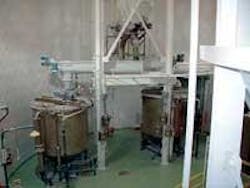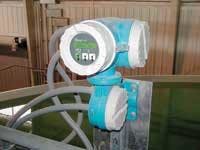New Lime Slaking System Helps Plant Gain Control of pH
Staff at the 22 mgd surface water lime softening treatment plant in Bloomington, IL, have gained much closer control of pH, with consequent tighter control over turbidity and other operating parameters, through replacement of a paste-type lime slaking system with a more advanced technology that features precise regulation of the slaking reaction and slurry dilution. They also note reduced maintenance and operational needs for the lime slaking operation and in other areas of the plant’s treatment process.
The plant has a design capacity of 22 mgd and sees an average of 11.5 mgd. It serves 22,000 connections in a community that is primarily agricultural. About 70% of the connections are residential, with the balance commercial and industrial.
Raw water enters from two lakes that are directly influenced by farmland runoff. The 640-acre Bloomington Lake, with an average depth of 15-16 ft. and a maximum of 30 ft., has a 70 sq. mi. runoff area that is 90% agricultural. Turbidity ranges normally from 3 to 8 NTU, and rises as high as 50 to 60 NTU after a hard rain. Nitrates can run as high as 13 to 14 ppm. When they exceed 10 ppm, plant input is switched to the other lake.
The 940-acre Evergreen Lake, with an average depth of 24-25 ft. and a maximum of 60 ft., has a 40 sq. mi. runoff area that is 70% agricultural. Turbidity ranges normally from 1 to 4 NTU, and rises as high as 15 NTU. Nitrates typically run 3 to 4 ppm lower than in Bloomington Lake.
The original treatment plant at the Bloomington site was built in 1929 as a WPA project, with a “home-made” slaker that used a Model T rear axle. The plant was upgraded over the years until 1987, when a new plant went on line next to the original. The new plant featured new high-lift pumps, additional gravity filters, and all-new chemical feeds, including lime, coagulants, chlorine, polymers, and activated carbon.
The slaker system installed at that time put out 1000 lb. per hr. of quicklime powder to slurry, so the slurry could be fed into the clarifiers to form a “lime blanket” that also included ferrous sulfate and cationic and anionic polymers. The blanket served to remove hardness, organics, dirt, and algae as water passed through.
A new slaking system was installed in 1998, but did not perform up to expectations.
In May 2001, the utility installed a Tekkem Slaker System, manufactured by RDP Technologies of Norristown, PA, under license from PR Stephansen, AS of Norway. The system has performed well, according to Greg Montague, maintenance crew leader.
“Our pH varies only about 0.1 now, compared to 0.3-0.4 previously,” he said. “Our raw water enters the plant at 8.6, increases to 11.3 at the clarifier, and finishes at 9.0. Previously, we could vary from 11.0 to 11.5 within several hours at the clarifier, due to slaker problems. Now, we vary only from 11.25 to 11.35 there.
The tighter process control has helped operators fine-tune turbidity, Montague said. Turbidity at the clarifier now runs about 0.4 to 0.5 NTU, where previously it would get as high as 2.0. The system has helped maintain turbidity at the discharge well below the plant’s 0.3 NTU limit.
“We no longer find ourselves often pushing the limit and having to scramble to keep under,” Montague said.
In addition, it now takes less work to operate and maintain the slaking system and it is easier to keep the slaking room and area clean. With the old system, each plant operator on duty had to spend 30-45 minutes per shift on maintenance − clearing the grit hole, adjusting the paddles, and manually operating the water valve.
“Now they don’t have to do all that, saving about an hour and a half a day. They just walk through and don’t even have to touch it,” Montague said.
“With the routine walk-through, and control room monitoring via SCADA, and often going two, three, and four weeks without any further attention required, like changing a solenoid valve or a limit switch, the total time required for operation and maintenance is about 10% of what it was.”
The improved process control has also resulted in operational and maintenance savings elsewhere in the plant.
“For example, with the gravity filters previously seeing turbidity as high as 2.0 off the clarifier, we used to have to backwash them every 24 or 48 hours. Now we’re more than likely to go 96 hours between backwashes, saving on energy and water. We’ve improved to 0.2 NTU after filtration on a bad day, and 0.08-0.06 on a good day.”
The Tekkem technology was installed as two redundant systems that can each deliver 2000 lbs. per hr. output, to allow for a planned upgrade of the plant to 30 mgd. Each system includes a feeder, slaker, slurry tank, and control panel, all provided by the manufacturer. Slaking temperature ranges from 194.5-195.5o F, with input temperature ranging from 37-80o.
“We think their load cell feeder system correlates with the much improved consistency we’re seeing now in the lime slurry tank,” said Montague. “The load cells are measuring mixing quantities of water and lime very accurately. We also put in a new lime loop system to the clarifiers, taking advantage of some of RDP’s design ideas.”
The RDP Tekkem Slaker uses direct weight control, coupled with temperature control, to maintain the accuracy of the slaking reaction, as well as subsequent dilution. The system has received numerous patents.
The company says it operates at temperatures in excess of 180 degrees F, and provides up to 10 minutes slaking time, with the system automatically adjusting parameters to maintain the high slaking temperatures for each batch. Slaker operation is designed to insure that all lime fed to the system is slaked at optimum slaking temperatures.
The system is described as almost maintenance-free. The slaker is sealed during slaking operations, which contains dust and steam. All control sensors are located outside the tank, away from the lime and water, to help eliminate maintenance and sensor errors.
For further information, visit RDP Technologies’ website at www.rdptech.com.



